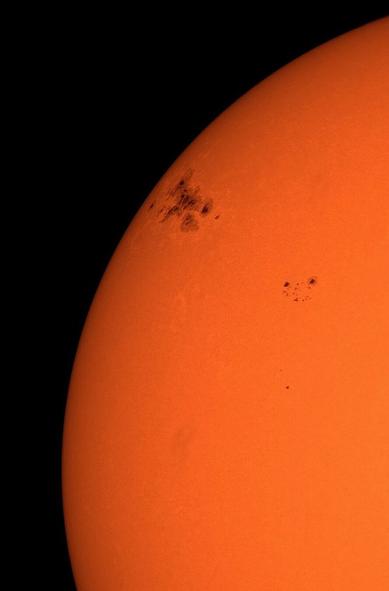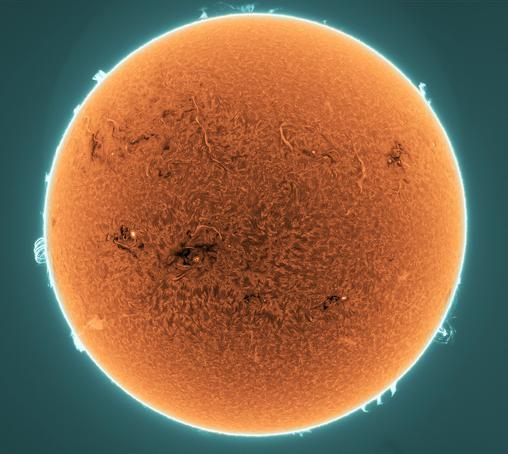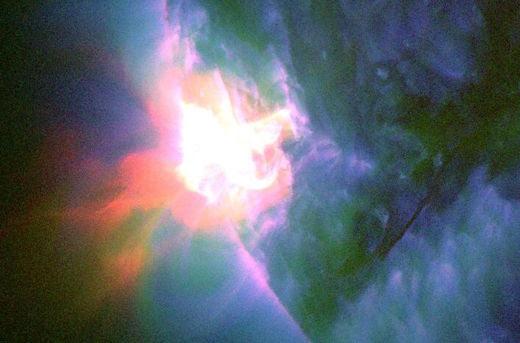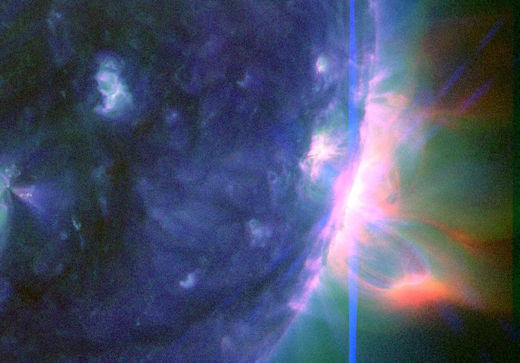#ar3664
#Sunspot #AR3664 #Astronomy #Sun #Space #SolarActivity #Astrophotography #SpaceLovers #Nature #Science #AstronomyLovers
#SpaceWeather news via #SolarHam
Near X-Flare
June 23, 2024 @ 14:50 UTC
"Is our old pal #AR3664 (3697 and now 3723) still active?
"Of course it is. A near #XFlare (M9.3) was detected at 13:01 UTC (Jun 23). The flare itself was fairly rapid, so a coronal mass ejection (CME) is likely not associated. We will get a better at the returning flare champion over the next few days.
"Now back for the third time, AR 3664 (3697) is returning into view from off the farside of the Sun. This region was first assigned 3664 on May 1st and would go on to produce non stop X-Flares and the resulting eruptions were responsible for the extreme #geomagnetic storm on May 10-11. It would reappear again on May 28th and was reassigned AR 3697 and would produce additional major solar flares. What will it have in store for us this time around? Stay tuned to find out."
Protubérances et filaments sur un soleil actif - L'image d'astronomie du jour - 15/06/2024
Cette image du Soleil, colorisée et aux détails accentués, est constituée de différentes poses enregistrant l'émission d'atomes d'hydrogène dans la chromosphère solaire le 15 mai 2024...
Image Crédit & Copyright : Steen Sondergaard
https://apod.nasa.gov/apod/ap240615.html
https://www.cidehom.com/apod.php?_date=240615
HARD RADIATION STORM: Sunspot AR3664 (now known as AR3697) just did it again. A powerful explosion on the sun today peppered Earth and nearby spacecraft with "hard" protons. The radiation storm fogged satellite cameras for hours. Following close behind, a CME is heading for Earth, and its arrival on June 10th could spark G2-class geomagnetic storms. https://spaceweather.com has updates.
No #GeomagneticStorm predicted yet. But with former #AR3664 (now #AR3697) belching out big flares, we might be in for another #Aurora treat soon...
#SpaceWeaherUpdate via #SolarHam
#XFlares Are Piling Up
June 1, 2024 @ 10:20 UTC
"Good morning. How about another X-Flare!
"The latest event measuring X1.4 was just detected around AR 3697 (3664) at 08:48 UTC (Jun 1). Much like the X-Flare yesterday evening, a CME does not appear to be associated with this event. Some dimming was observed to the north of 3697 before this event, but coronagraph imagery does not seem to reveal any plasma leaving the Sun. The flare producing machine is now in a good location for potential Earth directed eruptions.
"And with this now being the 49th X-Flare of the current solar cycle, we have tied the X-Flare total from the previous solar cycle 24. When will #50 take place? Stay tuned to find out."
EARTH IS BACK IN THE STRIKE ZONE: Returning sunspot AR3664 (now known as AR3697) is picking up where it left off two weeks ago. Today, it unleashed a long-duration X1.4-class solar flare, which caused a deep shortwave radio blackout over the Americas. From now on, every explosion will be geoeffective as the sunspot turns to squarely face our planet in the days ahead. Go to the smack zone on https://spaceweather.com
#SpaceWeather update via #SolarHam
"So is old region #AR3664 still active? Of course it is!
"An X2.9 solar flare was observed around the returning region at 07:08 UTC (May 27, 2024). The event is also responsible for an energetic coronal mass ejection (#CME) now emerging in updated coronagraph imagery. Because the sunspot region is still located behind the east limb, the flare itself was likely stronger than the X2.9 measurement. The CME itself should be directed away from our planet. We may see some busy days ahead of us. Stay tuned!"
Estimated X12 #SolarFlare from [presumed] #AR3664, which is on the far side of the Sun right now.
#CarringtonEvent was believed to be X45.
#AR3664 will be Earth-facing again soon.
"A fast moving, full halo coronal mass ejection (CME) is seen leaving the Sun this morning beginning around 05:30 UTC (May 20). Based on updated imagery, this event occurred on the farside of the Sun and is not Earth directed. Perhaps our old friend AR 3664 is up to its old tricks again. We should begin to see the big sunspot region turn back into view early next week."
Tiens, la dernière grosse tempête solaire a un article Wikipédia en 21 langues, mais pas en français https://en.wikipedia.org/wiki/May_2024_solar_storms
Aurora Banks Peninsula - L'image d'astronomie du jour - 17/05/2024
Vue plein sud depuis la péninsule de Banks, près de Christchurch sur l'île du Sud de la Nouvelle-Zélande. La base d'une tour rocheuse est visible au premier plan, avec les étoiles de la Croix du Sud en haut du cadre et le pôle céleste sud de la Terre près du centre...
Image Crédit & Copyright : Kavan Chay
#AR3664 is one big sunspot group and active region.
Pictured, a large multi-pronged solar prominence was captured extending from chaotic sunspot region AR 3664 out into space, just one example of the particle clouds ejected from this violent solar region.
La région active 3664 au limbe du soleil - L'image d'astronomie du jour - 15/05/2024
À quoi ressemblait la gigantesque région active à l'origine des récentes aurores lorsqu'elle se trouvait au bord du Soleil ? C'est là que AR 3664 a révélé au mieux sa structure en 3D...
Image Crédit & Copyright : Sebastian Voltmer
#AR3664 at the #Sun's Edge
#Astronomy #Picture of the Day
The latest #Spaceweather update from Spaceweather.com
"Because the sunspot is behind the edge of the solar disk, the flare was partially #eclipsed. It was probably even stronger than it appeared. 'X8.7' is almost certainly an underestimate of the flare's true strength.
"Extreme ultraviolet radiation from the flare ionized the top of Earth's atmosphere, causing a deep shortwave #RadioBlackout over the Americas. Ham radio operators, aviators and mariners may have noticed a sudden loss of signal at all frequencies below 30 MHz.
"Subatomic debris from this event might soon reach Earth, guided toward our planet by the #ParkerSpiral. Also, a #CME might be in the offing. Stay tuned for updates!
"EARTH IS CONNECTED TO SUNSPOT AR3664: Giant sunspot AR3664 is no longer facing Earth. That makes it extra dangerous. The #Carrington-class sunspot is passing over the sun's western limb--a region of the sun that is magnetically connected to our planet. Indeed, we are feeling the effects of that connection right now.
"What's causing this? Protons accelerated by solar flares in the magnetic canopy of #AR3664 are following the #ParkerSpiral back to Earth. Think of it as a magnetic superhighway. The arriving particles are funneled by our planet's magnetic field toward the poles where they ionize the atmosphere and interfere with the normal transmission of shortwave radio."
https://spaceweather.com/repeat_images/parkerspiral2.png
https://spaceweather.com/images2024/14may24/teal/20240514_165546_1024_0131.jpg
#SolarFlare #SpaceWx #AmateurRadio #SolarCycle25 #SolarFlares #Geomagneticstorm #HamRadio #Blackout
#SolarHam #Spaceweather Update:
Largest #SolarFlare Of #SolarCycle25 Observed
May 14, 2024 @ 17:05 UTC (UPDATED)
"The largest solar flare of the current solar cycle 25, and largest since 2017 was just observed around deparing #AR3664 off the west limb. The #X8.7 event peaked at 16:51 UTC (May 14) causing a strong R3 level radio blackout directly over North America. More to follow.
"And Then...
"An eruption in the vicinity of newly assigned #AR3682 measuring M4.4 was observed at 17:38 UTC (May 14). This event looks to be eruptive, meaning a #CME will be produced.
"Solar Cycle 25 just kicked it up a notch!"
#AmateurRadio #CMEs #SolarFlares #ParkerSpiral? #XClassFlares #SpaceWx
THE BIGGEST SOLAR FLARE OF THE CURRENT SOLAR CYCLE: Earth-orbiting satellites have just detected the most intense solar flare of the current solar cycle (so far)--an X8.7-category blast from giant sunspot AR3664. Extreme ultraviolet radiation from the flare ionized the top of Earth's atmosphere and caused a deep shortwave blackout over the Americas. As usual, https://Spaceweather.com is updating.
Image: Today's X8.7-class solar flare photographed by NASA's Solar Dynamics Observatory
#AR3664 #Flare #Solar #XCategory #Spaceweather #Shortwave #HamRadio #Blackout
I just saw that there was an #XClass #SolarFlare (X8.79?). Not sure where it originated from. If it's #AR3664, we could be in for a #ParkerSpiral event. More soon...
#SolarCycle25 #SolarFlares
I was asked when the best times are for viewing #aurora #Polarlicht so I plotted some statistics for the time of day in 3-hour windows, and their number of events with a strength of about kp7 and over, since 1870.
It's quite funny really but the time slots 6pm to midnight are the slots with the most events. 👀 🤔
I think #nuclear explosions can trigger "my" measurements. And depending on which time zone an explosion occurs in, there might be a bias toward Kazachstan's or USA nine-to-five office hours. So I removed all kp7 events on the day of an explosion and 3 days after.
(data for nuke tests from USGS earth quake monitoring and this blog https://www.johnstonsarchive.net/nuclear/tests/index.html )
But the odd time slot feature persists! 👀
Anyway: in case the huge sunspot #AR3664 that caused the magnificent skies comes around again in 2 weeks, the Northern Hemisphere has little chance to catch an aurora due to late sunsets and few events after dark in May (and full moon, too).
cc @iangriffin 🙂
#ClearSkies
La région active 3664 au soleil couchant - L'image d'astronomie du jour - 13/05/2024
Elle était beaucoup plus grande que la Terre. Elle était si grande qu'il était possible de la voir à la surface du Soleil sans grossissement. Elle contenait des champs magnétiques puissants et enchevêtrés, ainsi que de nombreuses taches solaires sombres...
Image Crédit & Copyright : Marco Meniero



